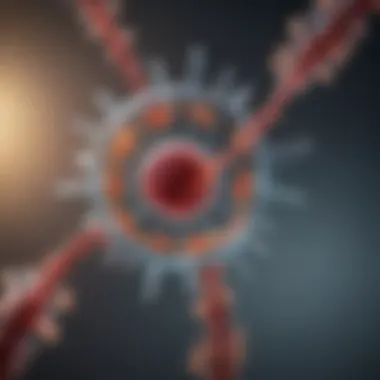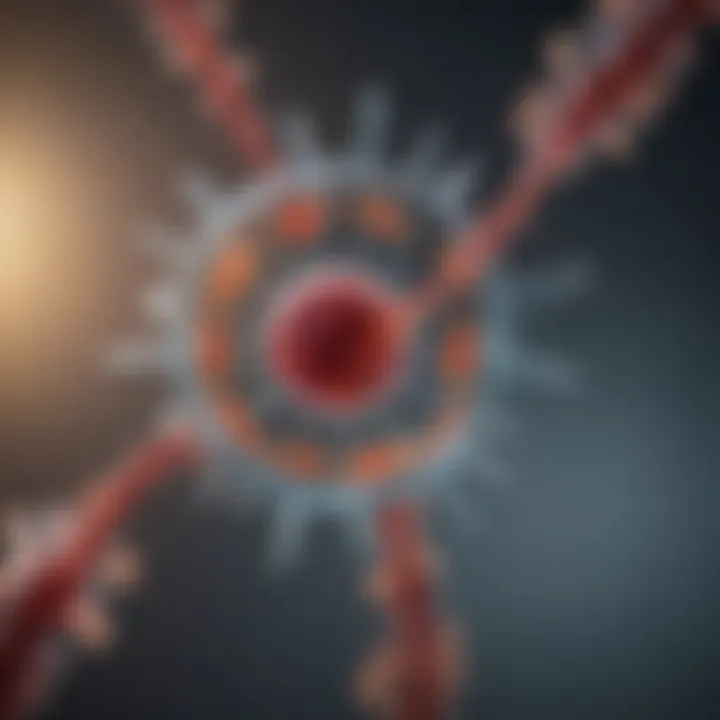Understanding Approved mRNA Vaccines: Insights and Impact


Intro
The emergence of mRNA vaccines marks a significant turning point in public health, particularly amid the global urgency brought on by pandemics. These vaccines utilize a novel approach that diverges from conventional methods of immunization. By leveraging the power of synthetic messenger RNA, these vaccines instruct cells to produce a harmless piece of the virus—specifically, the spike protein found on the surface of the coronavirus. This is not merely a background tale; it reflects a rapid evolution in vaccine technology that brings with it both promise and scrutiny.
Understanding mRNA vaccines encapsulates the intertwined journey of science, public health policy, and societal impact. The narrative we unfold here aims to deliver insight not only into the scientific principles that underpin these vaccines but also to expose their implications for community health and global strategies against infectious diseases. As we dissect the fundamental workings, it becomes imperative to consider both the advances achieved and the challenges that lay ahead.
Specifically, we will delve into recent advances in mRNA vaccine technology, evaluating the latest discoveries that bolster efficacy and safety while also highlighting technological innovations that pave the way for future applications. Additionally, we will approach the methodology behind the research supporting these vaccines to provide a glimpse into the rigors of scientific validation.
In a world where misinformation can spread just as rapidly as a virus, addressing common misconceptions becomes vital, thus ensuring informed discourse. This compendium aims to arm readers with knowledge pertinent not only to understanding mRNA vaccines but also engaging thoughtfully in critical conversations pertaining to public health.
With that, let us embark on a detailed exploration.
Preamble to mRNA Vaccine Technology
In the ever-evolving landscape of modern medicine, mRNA vaccine technology stands as a game-changer. These innovations not only revolutionize our approach to immunization but also redefine our understanding of how vaccines can harness the body’s innate processes to combat diseases. There is a pressing need to comprehend the intricacies of mRNA vaccines, as they form a cornerstone in the global effort to control and prevent infectious diseases.
Defining mRNA Vaccines
To start, let’s break down what mRNA vaccines are. They are a type of vaccine that use messenger RNA to instruct cells to produce a protein that triggers an immune response. Unlike traditional vaccines that often employ inactivated virus particles or weakened viruses, mRNA vaccines deliver genetic material that codes for specific viral proteins. Once this mRNA enters the cells, the body’s own machinery reads it, creating a protein that resembles a part of the virus. This prompts the immune system to recognize and remember that protein, thus preparing the body to fight off real infections in the future.
Understanding the simplicity of this process is crucial. It’s a remarkable shift from past practices. Instead of waiting for a live or killed virus to elicit an immune response, mRNA vaccines leapfrog into action by pushing the body to make the necessary proteins itself. This approach not only streamlines production but also allows for rapid technological advancements to keep pace with emerging viral variants.
Historical Context of Vaccine Development
To grasp the significance of mRNA vaccines, it helps to look back at the historical context surrounding vaccine development. The journey began with Edward Jenner's smallpox vaccine in the late 18th century, which laid the groundwork for immunology. Over the decades, scientists experimented with various techniques, such as live attenuated pathogens, inactivated pathogens, and subunit vaccines.
By the latter half of the 20th century, genetic engineering changed the game, paving the path for modern vaccines. However, conventional vaccine development’s lengthy timelines became evident with the rise of global pandemics. The urgent need for effective solutions highlighted the limitations of traditional methods. In this climate of urgency, mRNA technological advancements surged ahead, proving their worth particularly during the COVID-19 pandemic.
The landscape has shifted dramatically, transitioning vaccination from old-fashioned approaches to cutting-edge techniques aimed at saving lives more efficiently. Understanding this evolution not only illuminates the current capabilities of mRNA vaccines but sets the stage for their role in future health crises.
"Vaccine development has transformed from a lengthy process focused on traditional methods to a rapid, innovative approach leveraging mRNA technology, reflecting the ever-changing demands of public health."
Mechanisms of Action
Understanding the mechanisms of action for mRNA vaccines is crucial. It not only explains how these vaccines work but also underpins their effectiveness in combating diseases. The beauty of mRNA technology lies in its ability to instruct the body's cells to produce proteins that mimic parts of the virus, prompting an immune response. This section breaks down the processes involved, offering insights into both the biology and the implications for public health.
Understanding mRNA Delivery into Cells
To comprehend how mRNA vaccines function, it’s imperative first to grasp how mRNA is delivered into human cells. The mRNA, encased in lipid nanoparticles, is delivered directly into cells following injection. These tiny spheres act like delivery trucks, transporting the mRNA into cells with minimal disruption. Once inside the cell, the mRNA serves as a blueprint, instructing ribosomes to create viral proteins. It’s essential to highlight that mRNA does not interact with our DNA in any way; it operates in the cytoplasm, where protein synthesis occurs.
- Lipid Nanoparticles: These are vital for packaging the mRNA. They ensure stability and facilitate the entry of mRNA into cells, mimicking the natural mechanism of viral entry, albeit without any harmful effects of the virus itself.
- Cellular Uptake: Once the vaccine is injected into the muscle, it doesn’t stay localized. The mRNA travels to nearby lymph nodes, where immune cells encounter it. This exposure is what triggers the broad immune response, helping the body recognize and fight off potential infections effectively.
The Importance of Efficient Delivery: If the mRNA can’t get inside cells efficiently, it’s like trying to read a book in a locked room. Therefore, researchers focus extensively on optimizing these lipid nanoparticles to enhance delivery and uptake.
Immune Response Activation
Once the cells have produced the viral proteins as directed by the mRNA, the next step is activating the immune response. This process is multifaceted, involving various immune cells that work in concert to recognize and combat the foreign proteins.
Upon detection of these proteins, dendritic cells, a type of antigen-presenting cell, play a key role. They engulf the protein and present it on their surface, like a flag signaling danger. This action attracts T cells, particularly helper T cells, which are vital for orchestrating the adaptive immune response.
- T cells and B cells: T cells are like the army, initiating an attack against infected cells, while B cells produce antibodies that neutralize the virus and prevent it from entering cells.
- Immunological Memory: Importantly, the activation process creates memory cells, ensuring that if the body encounters the actual virus in the future, it can respond more rapidly and effectively.


"The immune response generated by mRNA vaccines is both immediate and long-lasting, providing critical protection against illness."
The activation of this immune response is one of the most significant advantages of mRNA vaccines. With their ability to create a robust, lasting defense, mRNA vaccines underscore a paradigm shift in vaccine technology, blending cutting-edge science with practical public health applications. The importance of comprehending these mechanisms cannot be overstated; they are instrumental in navigating the ongoing efforts to enhance vaccine efficacy and address emerging variants.
Approved mRNA Vaccines Overview
The significance of understanding approved mRNA vaccines cannot be overstated, especially in the context of current global health challenges. mRNA vaccines represent a remarkable shift in vaccine technology, offering advantages that traditional vaccines couldn’t match in terms of speed of development and adaptability. In this section, we will explore key approved mRNA vaccines, highlighting their importance, benefits, and the considerations surrounding their use.
Key mRNA Vaccines
When we talk about mRNA vaccines, two prominent examples immediately spring to mind: the Pfizer-BioNTech and Moderna vaccines, both of which have been pivotal in combating COVID-19.
- Pfizer-BioNTech (Comirnaty): Approved for emergency use in late 2020, this vaccine has shown remarkable effectiveness in preventing symptomatic COVID-19. Clinical trials indicated that it provided around 95% efficacy, a figure that’s hard to argue against. The Pfizer vaccine uses lipid nanoparticles to deliver mRNA that contains instructions for making the spike protein of the virus, which trigger an immune response without ever exposing the body to the virus itself.
- Moderna (Spikevax): Hot on Pfizer's heels, the Moderna vaccine quickly gained approval and showcased a slightly higher efficacy rate of about 94.1% in its clinical trials. The unique formulation of the Moderna vaccine also employs lipid nanoparticles, and it was designed to remain stable and effective at standard refrigeration temperatures, enhancing its logistical feasibility.
Both of these vaccines have become benchmarks for vaccine technology and have dramatically influenced public health policies worldwide.
Comparative Analysis of Different Vaccines
Understanding mRNA vaccines requires a deeper intrique not just between the specifics of their technology but also in their comparative performance. Let’s look at how the two leading mRNA vaccines stack up against each other and traditional vaccines.
- Efficacy Rates: While both the Pfizer and Moderna vaccines boast impressive efficacy rates, how do they compare against traditional vaccines like the flu shot? Traditional vaccines often range from 40% to 60% effectiveness in preventing illness, with a wide variance depending on the year and virus strain.
- Side Effects: The side effects of mRNA vaccines have raised eyebrows. Most side effects are mild and temporary, such as soreness at the injection site or fatigue. However, myocarditis, particularly in younger males after the second dose, has been a focal point in discussions around these vaccines. Traditional vaccines can also experience side effects, but the spectrum and severity tend to differ.
"Pfizer and Moderna vaccines have revolutionized our approach to immunization, showcasing the potential of mRNA technology in fighting not just COVID-19, but possibly other diseases in the future."
- Distribution and Storage: One definitive edge for Moderna has been its more favorable storage conditions, remaining stable at standard refrigerator temperatures, compared to the ultra-cold storage required for the Pfizer vaccine initially.
In summation, analyzing the specifics of these vaccines highlights not only their immediate impact in the fight against COVID-19 but also raises questions about future applications in public health strategies. The rapid advancements in mRNA technology make it clear that understanding these vaccines is not just about assessing their efficacy but about appreciating their transformative potential in medicine.
Efficacy and Safety Profiles
When it comes to any medical intervention, understanding the efficacy and safety profiles of approved mRNA vaccines holds paramount importance. These aspects are crucial not just for the scientific community, but also for the general public, healthcare providers, and policymakers. The efficacy of these vaccines indicates how well they can prevent disease, while safety profiles reveal the risks and benefits associated with their use. By scrutinizing these elements, we can build trust and promote informed decision-making regarding vaccination.
Clinical Trials and Findings
Clinical trials serve as the bedrock for determining the effectiveness and safety of mRNA vaccines. Before any vaccine gets to the public, it undergoes a series of rigorous phases that evaluate its performance.
- Phase 1: A small group of healthy volunteers receives the vaccine to assess its safety and dosage levels.
- Phase 2: The vaccine is administered to a larger group to further evaluate its safety and the immune response it elicits.
- Phase 3: Thousands of participants are involved to determine how well the vaccine works in preventing illness compared to a placebo.
Take the case of the Pfizer-BioNTech COVID-19 vaccine. In its Phase 3 trial, which reported findings in late 2020, results showed approximately 95% efficacy in preventing symptomatic COVID-19. This overwhelming statistic not only highlighted its effectiveness but also paved the way for regulatory approval. Participants reported mild to moderate side effects, the most common being soreness at the injection site, fatigue, and headache. Despite some reports of more serious reactions, these were exceedingly rare and outweighed by the benefits of vaccination.
"The findings from clinical trials are essential not just for gaining emergency use authorization, but also for shaping public perception about the overall safety of vaccines."
Continued monitoring during these trials ensures any potential red flags are caught early. Researchers analyze the data meticulously, scrutinizing factors like age, gender, and pre-existing conditions to understand how different populations respond. This inclusion is particularly relevant when talking about vaccine efficacy across diverse demographic groups.
Post-Marketing Surveillance Data
Once a vaccine receives approval, the journey does not end there. Post-marketing surveillance becomes vital in ensuring the ongoing safety and effectiveness of mRNA vaccines. This extensive monitoring system collects data from real-world applications, allowing researchers to identify any long-term effects or unexpected adverse events.
The Vaccine Adverse Event Reporting System (VAERS) serves as one of the primary platforms for this endeavor in the United States. Here, healthcare professionals and the public can report any side effects they think are related to vaccines. The information gathered helps agencies like the CDC and FDA to monitor trends and identify potential safety concerns.
- A notable observation: After the mass vaccination rollout of COVID-19 vaccines, reports of myocarditis (inflammation of the heart) surfaced, especially among younger males.
- Response from agencies: This prompted health authorities to further investigate this link, highlighting the importance of transparency in the communication of risks.
Post-marketing studies also contribute to a more nuanced understanding of vaccine effectiveness in different populations. For instance, while the clinical trials might include a diverse set of participants, not every demographic may be similarly represented. Ongoing data collection helps fill these gaps and ensures comprehensive safety assessments moving forward.


In summary, the efficacy and safety analysis of approved mRNA vaccines is an intricate web of clinical trials, post-marketing surveillance, and ongoing evaluations. Each layer adds depth to our understanding and strengthens public health strategies aimed at ensuring widespread immunity.
Public Health Implications
The topic of public health implications surrounding mRNA vaccines is crucial in today’s evolving healthcare landscape. It goes beyond individual benefits, diving into the broader community welfare. These vaccines have revolutionized the way we respond to infectious diseases and have introduced new paradigms in preventive medicine. The main benefits of implementing mRNA vaccines include increased vaccination rates, the potential for herd immunity, and the ability to respond to health crises in real time.
Vaccination and Herd Immunity
Vaccination alone is powerful, but when you get enough people vaccinated, you open the door to herd immunity. This is when a large percentage of the population being vaccinated significantly reduces the spread of the disease. It’s like a protective wall that shields the community. Given that mRNA vaccines, such as those developed by Pfizer-BioNTech and Moderna, have shown high efficacy, they serve as a solid foundation for achieving this goal.
- Protecting Vulnerable Populations: Herd immunity is particularly beneficial for those who cannot be vaccinated, such as individuals with certain medical conditions. By getting vaccinated, healthier individuals are helping to protect those who are more vulnerable.
- Slowing Down Transmission: A vaccinated populace can lead to dramatically reduced virus circulation, which is essential in controlling outbreaks.
- Longer-Term Freedom: Widespread vaccination with effective mRNA vaccines can facilitate the return to normalcy in everyday life, including in schools, workplaces, and public gatherings.
By boosting the overall immunity of the community, mRNA vaccines play a pivotal role in preventing outbreaks and protecting those who are unable to get vaccinated. The relationship between vaccination coverage and herd immunity can set the stage for eventual disease elimination in the future.
Role in Pandemic Response
The role of mRNA vaccines in pandemic response is transformative and multifaceted. When the world was confronted with the COVID-19 pandemic, traditional vaccine development timelines were pushed to the limits. mRNA technology allowed scientists to pivot quickly, leading to the swift arrival of vaccines on the market. This rapid response is critical in curbing pandemics before they spiral out of control.
- Rapid Development: mRNA vaccines can be developed in a timely manner. This is a game changer during emergencies when time is of the essence.
- Scalability: These vaccines can be produced at scale more easily than traditional methods. This means manufacturers can meet the demand during a public health crisis.
- Adaptability: The technology behind mRNA vaccines allows for easy updates to vaccines in response to emerging variants, ensuring that the immunization remains effective against evolving pathogens.
"mRNA technology represents a paradigm shift in vaccine development and response strategy, showcasing the power of scientific innovation to meet urgent health demands."
Addressing Concerns and Misunderstandings
Addressing concerns and misunderstandings surrounding mRNA vaccines is pivotal in the dialogue about public health. The rapid development and deployment of these vaccines have sparked a mix of curiosity and skepticism among various demographics. Whether stemming from anecdotal experiences or misinformation circulating online, addressing these worries is not just beneficial but essential for widespread acceptance and utilization of mRNA technology.
Clarifying Myths Surrounding mRNA Vaccines
A recurring theme in discussions about mRNA vaccines is the prevalence of myths that can shape perceptions and decision-making. One major misconception is that mRNA vaccines alter an individual’s DNA. This belief likely arises from a basic misunderstanding of how mRNA functions. Importantly, mRNA works as a messenger that directs cells to produce a protein associated with a pathogen, in this case, the spike protein of the SARS-CoV-2 virus. It does not enter the cell nucleus where DNA resides, thus leaving DNA unharmed.
Another significant myth is that mRNA vaccines contain live viruses. This is not the case. Instead, the vaccines include synthetic mRNA strands that prompt the body to create an immune response without using the actual virus, which is a crucial distinction. Educating the public on these facts helps to mitigate fear and supports informed choices about vaccination.
"Vaccination is not just about individual protection; it's about community health."
Furthermore, some argue that the speed of mRNA vaccine development undermines safety. In reality, numerous advancements in technology, increased funding, and unprecedented global collaboration allowed for expedited efforts without sacrificing the rigorous standards of safety and efficacy that are the hallmark of vaccine development. Clarifying these myths is crucial not just for individual comprehension but also for enhancing community trust in mRNA vaccines.
Examining Side Effects and Reactions
The discussion about side effects and reactions to mRNA vaccines is another area that merits thorough examination. Generally, side effects can range from mild symptoms to more severe reactions, but most fall within the category of common responses to vaccination, such as soreness at the injection site, fatigue, and low-grade fevers. These reactions are typically short-lived and indicate that the body is generating an immune response.
However, serious side effects, such as myocarditis or severe allergic reactions, albeit extremely rare, remain a concern for many. Data demonstrates that while these incidents can occur post-vaccination, the occurrence rate is very low compared to the risks associated with the disease itself. The importance of transparency in reporting these findings cannot be overstated. By openly discussing potential risks alongside the significant benefits of vaccination, a more balanced understanding can emerge.
- Common side effects include:
- Rare but reported severe reactions:
- Pain at the injection site
- Fatigue
- Headaches
- Muscle pain
- Myocarditis
- Anaphylaxis
In essence, fostering a conversation that acknowledges both the realities of side effects, alongside the greater dangers presented by the disease, can empower individuals to make more informed health decisions. Keeping the lines of communication open between healthcare providers and the community can greatly enhance public confidence in mRNA vaccines and ultimately lead to better health outcomes.
Ongoing Research and Future Directions


The landscape of mRNA vaccine technology is not static. As we move forward, ongoing research and innovations are at the forefront of expanding this remarkable tool in medicine. In this section, we explore the critical elements driving future directions in mRNA vaccine development, highlighting the benefits and considerations that are shaping its evolution.
Innovation in Vaccine Development
Innovation in vaccine development isn’t just a catchphrase; it’s a necessity in today’s fast-paced world of infectious diseases. Researchers are tirelessly exploring new platforms and methodologies to enhance the efficacy and scope of mRNA vaccines. For example:
- Next-Generation Vaccines: Scientists are working on combining mRNA technology with nanoparticle systems. This could improve the delivery and stability of vaccines, ensuring a stronger immune response.
- Storage Solutions: One major challenge with current mRNA vaccines is their storage temperature. Researchers are developing formulations that can withstand higher temperatures, which will facilitate distribution, especially in less accessible regions.
- Universal Vaccines: There's excitement around the potential for universal vaccines that could target multiple strains or types of viruses, particularly in the case of flu or coronaviruses. This forward-thinking could significantly impact public health by providing broader protection from virus mutations.
Furthermore, collaborations between public health organizations and private biotechnology firms have spurred a lively environment for innovation, paving the way for breakthroughs that could reshape our understanding of vaccines.
Potential Applications in Other Diseases
One of the more exhilarating prospects of mRNA technology is its potential beyond infectious diseases. Researchers are keenly investigating how the principles that underpin mRNA vaccines could be adapted for various health challenges. Some of the possible applications include:
- Cancer Treatment: mRNA vaccines are being studied for their ability to instruct the body’s immune system to recognize and combat cancer cells. By harnessing the body’s own defenses, it's a promising avenue that could revolutionize cancer therapies.
- Autoimmune Diseases: Scientists are exploring mRNA to create therapies for inflammatory and autoimmune diseases. These could target specific proteins involved in these conditions, potentially providing more personalized treatment options.
- Allergies and Asthma: Ongoing research is also looking into how mRNA can be employed to modify the immune response to allergens, providing a new way to manage these common conditions.
Advances in mRNA technology could lead to vaccines and therapies that provide protection across a spectrum of diseases, from flu to cancer.
As these avenues are explored and developed, ongoing research not only aims to refine existing vaccines but also to broaden their applications. Each step taken today builds a foundation for the transformative role mRNA could play in the future of medicine.
In summary, the journey of mRNA vaccines is far from over. Ongoing research continues to uncover new possibilities, pushing the boundaries of what's achievable and potentially changing the face of medicine as we know it.
Regulatory and Approval Processes
The journey of an mRNA vaccine from initial concept to its administration in a healthcare setting is paved with meticulous regulatory and approval processes. These protocols assure that vaccines are not only effective but also safe for public use. This section explores the intricacies of these processes, highlighting their significance in the broader context of public health.
Understanding Vaccine Approval Mechanisms
Vaccine approval mechanisms involve a series of steps designed to rigorously evaluate the safety, efficacy, and quality of a vaccine before it reaches the arms of the public. The process starts with preclinical studies, where candidates undergo laboratory testing to assess their potential as effective vaccines. When a vaccine progresses to clinical trials, it typically unfolds in three pivotal phases:
- Phase 1: This phase involves a small group of healthy volunteers. The primary goal is to evaluate the vaccine’s safety and the immune response it triggers. Side effects are closely monitored during this stage.
- Phase 2: Here, dozens to hundreds of individuals participate, which helps researchers gain more data on the vaccine's efficacy and further evaluate its safety in a larger population.
- Phase 3: This extensive phase includes thousands of participants. It tests the vaccine's effectiveness in preventing disease compared to a control group without the vaccine. Positive results from this phase are essential for regulatory approval.
Moreover, the manufacturers compile all findings in an application known as a Biologics License Application (BLA) for submission to regulatory bodies like the FDA in the United States. A critical aspect of these mechanisms is understanding the balance between accelerated timelines seen during public health emergencies and the need for thorough evaluations.
Role of Regulatory Agencies
Regulatory agencies play a pivotal role in the vaccine approval landscape, acting as gatekeepers to ensure that any vaccine introduced into the market meets high standards of safety and effectiveness. Agencies such as the U.S. Food and Drug Administration (FDA) and the European Medicines Agency (EMA) oversee the approval processes, but their roles are not just limited to initial licensure.
Once a vaccine is authorized, these agencies continue to monitor its performance through post-marketing surveillance systems such as the Vaccine Adverse Event Reporting System (VAERS). This ongoing observation helps to ensure that any rare or long-term side effects can be quickly identified and addressed. Regulatory frameworks also evolve to accommodate new technologies, reflecting the dynamic landscape of vaccine development.
"The rigorous scrutiny by regulatory agencies is akin to the protective gate held by a vigilant guardian, safeguarding public health while allowing innovation to flourish."
Epilogue: The Future of mRNA Technology
As we wrap up this exploration into mRNA vaccines, it’s crucial to emphasize the significance of this topic, especially in the current public health landscape. The discussion around mRNA technology does not merely focus on its present application but also highlights its profound potential for future innovations.
Summation of Key Points
In reviewing the journey of mRNA vaccines, several pivotal aspects come to light:
- Innovative Mechanisms: mRNA technology presents an advanced way of inducing immune responses. By utilizing messenger RNA to instruct cells to produce specific proteins that trigger an immune reaction, this approach is both efficient and adaptable.
- Efficacy and Safety: Approved mRNA vaccines have demonstrated high efficacy rates in preventing severe diseases, supported by extensive clinical trial data and ongoing post-marketing surveillance. Comparisons indicate these vaccines are effective against evolving virus variants.
- Public Health Impact: The role of mRNA vaccines in achieving herd immunity and responding to pandemics can’t be understated. These vaccines have enabled quicker reaction times to viral outbreaks, bolstering global health security.
- Addressing Concerns: Through continuous education, many myths surrounding mRNA vaccines have been debunked. Active discussions help to clarify potential side effects, ensuring informed decisions among the public.
Looking Ahead
The horizon for mRNA technology seems bright, offering various pathways for further advancements:
- Broadening Applications: Beyond COVID-19, there’s potential for mRNA vaccines in creating solutions for other infectious diseases, like influenza and Zika, and even non-infectious conditions such as cancer. As research continues, possibilities may emerge that were previously unthinkable.
- Continuous Innovation: The technology is evolving. Innovations may lead to more effective delivery systems and adjuvants that enhance vaccine responses. This ongoing research will likely result in a more robust immune defense and perhaps personalized vaccines in the future.
- Global Cooperation: With a strong backing from governments and international organizations, collaborations can enhance production capabilities, ensuring equitable distribution of these vaccines worldwide. Such efforts are paramount for both public health and the economy.
"The role of mRNA technology in vaccine development is just the tip of the iceberg; what lies beneath is a vast ocean of possibilities."















